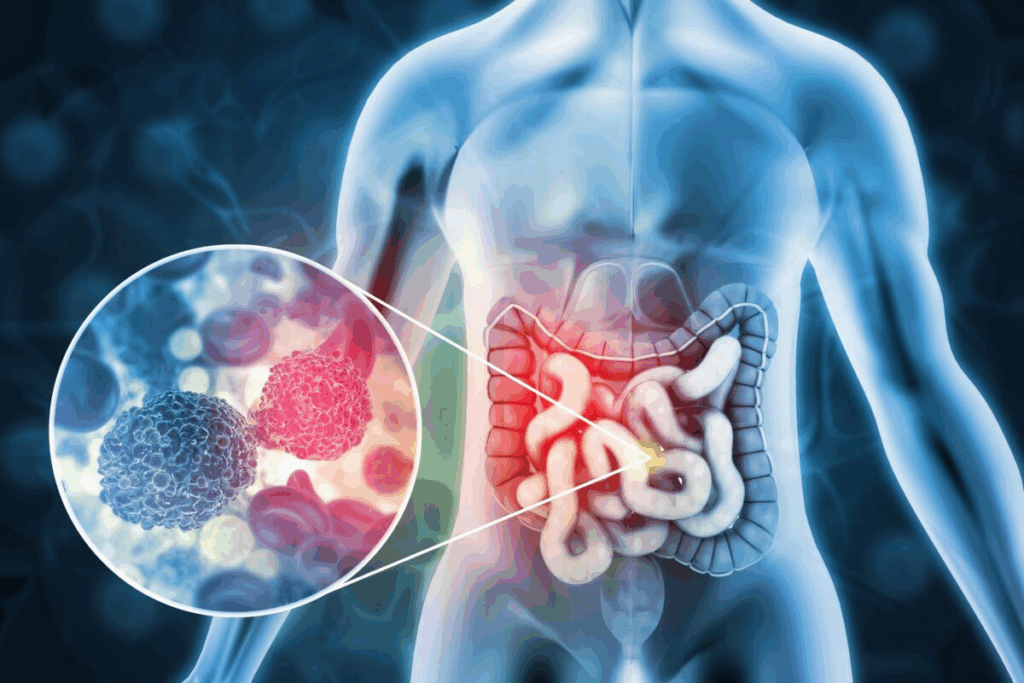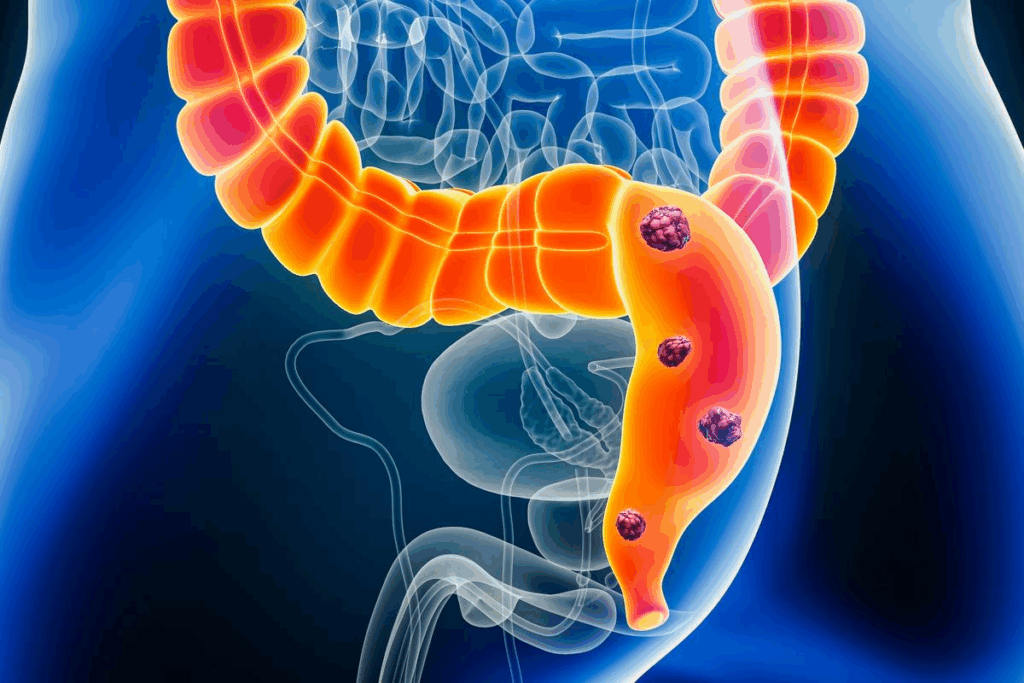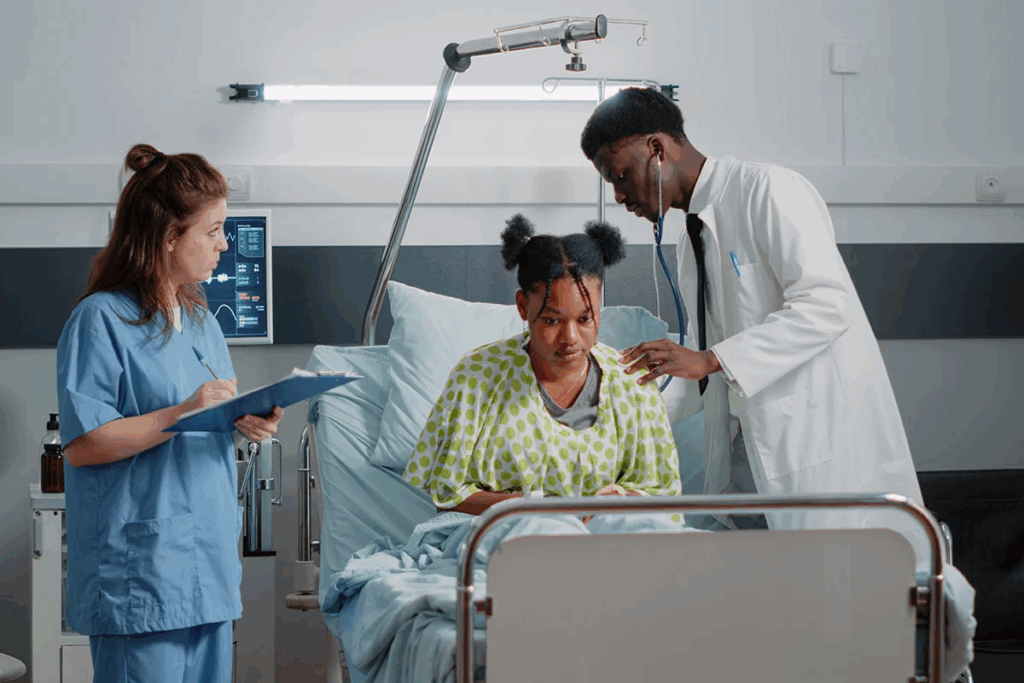Last Updated on October 30, 2025 by Bilal Hasdemir

It’s important to know about the different colon surgery types to make good health choices. Surgery is a key treatment for colorectal cancer. For many, it’s a big part of their treatment. Discover key colorectal procedures, their benefits, and how to find nearby surgeons.
Liv Hospital focuses on patient care and medical skill. They make sure your journey to better colorectal health is in good hands. They offer many colorectal surgeries. It’s key to find a skilled surgeon for the best care.

The health of the colon and rectum is key for good digestion and overall health. These organs are vital in the digestive system. Keeping them healthy helps prevent many stomach problems.
Many conditions might need surgery to fix colon and rectal health. These include colorectal cancer, Crohn’s disease, and ulcerative colitis. Knowing about these conditions helps find the right treatment.
For example, colorectal cancer might need surgery to remove the bad part. This could be a colectomy, right and left hemicolectomy, or sigmoid colectomy. These colon procedures are key for treating cancer and other serious issues.
When these conditions are found, picking the right treatment is important. Surgery might be needed to take out the bad parts. This can help symptoms go away and improve life quality.
Choosing surgery depends on how bad the condition is, the patient’s health, and if other treatments work. For many, surgery is a good way to fix health and ease symptoms.
It’s important for patients to talk to a colorectal surgeon about treatment. These experts can explain the colorectal surgical procedures and help patients decide what’s best for them.
| Condition | Common Surgical Procedures |
| Colorectal Cancer | Colectomy, Hemicolectomy, Sigmoid Colectomy |
| Crohn’s Disease | Colectomy, Proctectomy |
| Ulcerative Colitis | Total Colectomy, Proctocolectomy |

It’s important for both patients and doctors to know about colorectal surgery. This surgery treats problems in the colon and rectum. It includes many different procedures.
Colorectal surgery has changed a lot over time. Now, it uses both old and new methods. The choice of method depends on the patient’s health, the disease, and the surgeon’s skills.
Colorectal surgery has made big steps forward. Minimally invasive techniques like laparoscopic and robotic surgeries are now common. They have smaller cuts, less pain, and quicker healing.
New technology in surgery has also helped. It makes surgeries more precise and safe. This leads to better results for patients.
Older surgery methods need bigger cuts and take longer to heal. New, smaller cuts and quicker healing are the benefits of modern surgery.
| Aspect | Traditional Open Surgery | Minimally Invasive Surgery |
| Incision Size | Larger incisions | Smaller incisions |
| Recovery Time | Longer recovery | Faster recovery |
| Postoperative Pain | More pain | Less pain |
Choosing the right surgery for a patient is complex. It depends on the patient’s health, the disease, and the risks and benefits of each surgery.
Patient-specific factors are key in picking the best surgery. Doctors must consider these to give the best care.
Colectomy is a major surgery for colon problems. It can remove part or all of the colon. This is needed for colon cancer, severe inflammatory bowel disease (IBD), and other colon issues.
Colectomy comes in two types: total and segmental. A total colectomy removes the whole colon. On the other hand, a segmental colectomy, or partial colectomy, takes out just the sick part.
The choice depends on the disease, the patient’s health, and the surgeon’s opinion. For example, with colon cancer, a segmental colectomy might be chosen to remove the cancer and some healthy tissue too.
After a colectomy, care is key for a good recovery. Patients stay in the hospital for a few days. The recovery timeline varies based on health and surgery extent.
Colectomy has risks like infection, bleeding, and adhesions. Long-term results depend on the condition and the patient’s health.
For colon cancer, the outlook changes with the cancer’s stage. For IBD, colectomy can greatly improve life by easing symptoms.
In summary, colectomy is a big surgery needing careful thought and planning. Knowing about the types, care after surgery, and possible outcomes is key for both patients and doctors.
Right and left hemicolectomy are surgeries that remove parts of the colon. These surgeries help treat colon issues while keeping as much colon function as possible.
The right hemicolectomy removes the right colon, including the cecum and ascending colon. It’s used for tumors or diseases in this area. A left hemicolectomy removes the left colon, including the descending and sometimes transverse colon. Knowing the anatomy is key for surgeons to decide how much to remove and keep the colon’s blood supply.
Anatomical considerations are vital for these surgeries. The colon’s blood supply, nearby organs, and the patient’s body shape affect the surgery. Surgeons plan carefully to get the best results.
Hemicolectomy is mainly for colon tumors or cancer. Right hemicolectomy treats right colon issues like tumors or complex polyps that can’t be removed by endoscopy. Left hemicolectomy is for left colon problems, like diverticulitis or tumors.
Recovering from a hemicolectomy means a hospital stay followed by getting back to normal slowly. Patients watch for complications and follow diet and lifestyle advice. Post-operative care is key for a smooth recovery and to avoid complications.
After a hemicolectomy, bowel habits may change, but most people get back to normal in a few weeks. Diet changes might be needed to manage bowel function and avoid discomfort.
Sigmoid colectomy is a colon surgery used to treat the sigmoid colon. It removes the sigmoid colon. This is a common treatment for conditions like sigmoid colon cancer.
Sigmoid resection is recommended for several reasons:
The decision to have sigmoid resection is based on thorough evaluation. This includes imaging studies and biopsy results. Early diagnosis is key for effective treatment and better outcomes.
Sigmoid colectomy can be done in different ways:
Each method has its advantages and considerations. The choice depends on the patient’s condition, the surgeon’s skill, and other factors.
“The choice of surgical technique in sigmoid colectomy is critical for optimizing outcomes and minimizing complications.” –
A renowned colorectal surgeon
The recovery after sigmoid colectomy includes:
Restoration of bowel function is a key part of recovery. Most patients return to normal bowel habits over time.
It’s important for patients and healthcare providers to understand sigmoid colectomy. By making informed decisions, patients can get the best results.
Proctectomy is a surgery that removes the rectum. It’s used to treat rectal cancer and other conditions. The type of surgery depends on the tumor’s location, the patient’s health, and how far the disease has spread.
There are two main surgeries for proctectomy: Low Anterior Resection (LAR) and Abdominoperineal Resection (APR). LAR is used for tumors higher up in the rectum. It helps keep the anal sphincter intact, allowing for normal bowel movements. APR is for tumors near the anus. It removes the anus and surrounding tissues, leading to a permanent colostomy.
Choosing between LAR and APR depends on the tumor’s location, size, and stage. It also depends on the patient’s health and what they prefer. Understanding both procedures is key.
| Surgical Procedure | Tumor Location | Sphincter Preservation | Outcome |
| Low Anterior Resection (LAR) | Higher rectal tumors | Yes | Normal bowel function maintained |
| Abdominoperineal Resection (APR) | Lower rectal tumors | No | Permanent colostomy |
Sphincter-preserving techniques aim to keep bowel function normal. They’re key in LAR procedures. Advances in surgery have made these techniques more effective, improving patients’ quality of life after surgery.
After proctectomy, bowel habits may change. It’s important to manage these changes for a smooth recovery. This can include dietary changes, bowel training, and medication for symptoms like diarrhea or constipation.
Knowing about post-surgical bowel changes is vital for patients. A colorectal surgeon can help understand what to expect and how to adapt.
The hemorrhoidectomy is a common surgery for hemorrhoids. These are swollen veins in the rectum or anus. Surgery is needed when symptoms are severe.
Treatments for hemorrhoids vary. Some methods are non-surgical, like lifestyle changes and rubber band ligation. These are often tried first because they’re less invasive.
Surgical options are for more serious cases. Hemorrhoidectomy is one such surgery. It helps those with severe symptoms.
Other common surgeries include fixing fistulas and treating fissures. An anal fistula is an abnormal connection, and an anal fissure is a tear. Both can be painful and may need surgery.
Fistula repair closes the abnormal connection. Fissure treatment might use medicine or surgery to help heal.
Many surgeries, like some hemorrhoidectomies, are done on an outpatient basis. This means patients go home the same day. It helps reduce hospital stay time.
Managing pain is key after surgery. Doctors might use medicine, diet changes, and wound care. Patients learn how to handle pain and heal at home.
Recovery times vary by surgery. For example, it can take weeks to recover from a hemorrhoidectomy. Patients need to adjust their activities and follow instructions carefully.
Minimally invasive colorectal surgery has changed the game in treating colon and rectal issues. It makes recovery faster and improves results. Benefits include smaller cuts, less pain, and shorter hospital stays.
A study in a top medical journal says this surgery is now the go-to for many colon issues. Laparoscopic and robotic-assisted methods are used more often in these surgeries.
Laparoscopic surgery uses small cuts for a camera and tools. It allows for precise work and less damage to tissues. This method leads to quicker healing and fewer problems than open surgery.
Robotic surgery gives better control and precision than laparoscopy. It offers a 3D view of the area, making dissection and repair more accurate. It also means less blood loss and fewer open surgery needs.
ERAS protocols help patients recover better after surgery. They include pre-op talks, standard pain and anesthesia plans, and early movement. These steps cut down hospital stays and complications.
Studies have looked at how fast patients recover with different surgeries. They found minimally invasive methods lead to quicker healing and fewer issues. Here’s a summary of the findings.
| Surgical Approach | Recovery Time | Complication Rate |
| Laparoscopic | 2-4 weeks | 10-15% |
| Robotic-Assisted | 2-4 weeks | 5-10% |
| Open Surgery | 6-8 weeks | 20-25% |
Minimally invasive surgery clearly offers big advantages in recovery and complication rates. As technology gets better, we can expect to see more of these methods in colon and rectal surgery.
Finding a good colorectal surgeon is very important. It’s a big decision because of the complex nature of colon and rectal issues. The right surgeon can greatly affect your treatment and recovery.
Look for a surgeon who is board certified. Board certification shows they’ve passed tough training and meet high standards. They also need specialized training in colorectal surgery. This training helps them use the latest methods for treating colon and rectal problems.
General surgeons can do many surgeries, but colorectal specialists focus on colon and rectal surgery. Their focus on these areas can lead to better results for complex problems. When searching “colon and rectal surgery near me,” look for surgeons with colorectal surgery fellowship training.
Online searches can help find surgeons near you. But, it’s important to check their credentials and patient feedback. Also, ask your doctor or other healthcare workers for recommendations.
Before your consultation, prepare your questions. Here are some:
These questions help you make a smart choice about your care. They ensure you’re in good hands with your surgeon.
| Criteria | General Surgeon | Colorectal Specialist |
| Training | General surgery residency | Fellowship training in colorectal surgery |
| Experience | Varied surgical experience | Specialized experience in colon and rectal surgery |
| Complex Procedures | May refer complex cases | Experienced in complex colorectal procedures |
By carefully looking at these factors and asking the right questions, you can find a skilled colorectal surgeon. They will provide the best care for you.
Understanding colorectal surgery is key to making good choices. Knowing about the different colon surgery types helps patients decide what’s best for them.
Seeing a colorectal surgeon is a big step. It lets patients talk about their options and learn what to expect. This is important for colorectal surgery.
Being well-informed helps patients feel more confident. This confidence leads to better results and a better life. It’s important for people to be active in their care. They should ask questions and get a second opinion if needed. This ensures they get the best treatment.
Colon and rectal surgery treats problems in the colon, rectum, and anus. This includes cancer, diverticulitis, and hemorrhoids.
There are many types of colorectal surgery. These include colectomy, hemicolectomy, and sigmoid colectomy. Also, proctectomy and hemorrhoidectomy are part of it.
Look for a surgeon who is board certified and has specialized training. Use “colon and rectal surgery near me” or “colorectal surgeons in my area” to find them.
A colorectal surgeon specializes in the colon, rectum, and anus. A general surgeon may not have the same expertise.
Laparoscopic colorectal surgery is a minimally invasive method. It uses small incisions and a camera for less pain and faster recovery.
ERAS protocols help patients recover faster. They reduce pain, complications, and help you get back to normal activities sooner.
Recovery varies by procedure. You’ll follow a care plan that includes pain management and dietary changes. You’ll also have follow-up appointments.
Yes, there are non-surgical options for hemorrhoids. These include lifestyle changes and treatments like rubber band ligation and sclerotherapy.
Total colectomy removes the whole colon. Segmental colectomy removes part of the colon, depending on the disease’s location and extent.
Managing bowel changes may involve dietary changes and medication. You may also need bowel habits training. Always talk to a healthcare provider.
Subscribe to our e-newsletter to stay informed about the latest innovations in the world of health and exclusive offers!
WhatsApp us